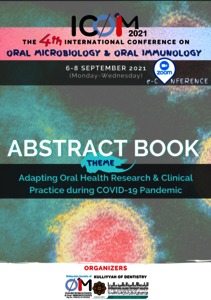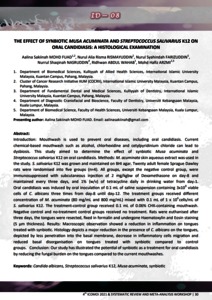Mohd Fuad, Aalina Sakiina and Rismayuddin, Nurul Alia Risma and Farizuddin, Nurul Syahindah and Nasruddin, Nurrul Shaqinah and Abdul Wahab, Ridhwan and Arzmi, Mohd Hafiz (2021) The effect of synbiotic Musa acuminata and Streptococcus salivarius K12 on oral candidiasis: a histological examination. In: The 4th International Conference on Oral Microbiology & oral Immunology, International Islamic University Malaysia. (Unpublished)
![[img]](http://irep.iium.edu.my/93289/1.hassmallThumbnailVersion/Cover%20page.png)
|
PDF
Download (1MB) | Preview |
|
![[img]](http://irep.iium.edu.my/93289/2.hassmallThumbnailVersion/ID-08.png)
|
PDF
Download (834kB) | Preview |
Abstract
Introduction: Mouthwash is used to prevent oral diseases, including oral candidiasis. Current chemical-based mouthwash such as alcohol, chlorhexidine and cetylpyridinium chloride can lead to dysbiosis. This study aimed to determine the effect of synbiotic Musa acuminata and Streptococcus salivarius K12 on oral candidiasis. Methods: M. acuminata skin aqueous extract was used in the study. S. salivarius K12 was grown and maintained on BHI agar. Twenty adult female Sprague Dawley rats were randomised into five groups (n=4). All groups, except the negative control group, were immunosuppressed with subcutaneous injection of 2 mg/kgbw of Dexamethasone on day-8 and maintained every three days, and 1% (w/v) of tetracycline daily in drinking water from day-1. Oral candidiasis was induced by oral inoculation of 0.1 mL of saline suspension containing 3x108 viable cells of C. albicans three times from day-8 until day-12. The treatment groups received different concentration of M. acuminata (80 mg/mL and 800 mg/mL) mixed with 0.1 mL of 1 x 106 cells/mL of S. salivarius K12. The treatment-control group received 0.1 mL of 0.06% CHX-containing mouthwash. Negative control and no-treatment control groups received no treatment. Rats were euthanised after three days, the tongues were resected, fixed in formalin and undergone Haematoxylin and Eosin staining (5 µm thickness). Results: Macroscopic observation showed a reduction in inflammation on tongues treated with synbiotic. Histology depicts a major reduction in the presence of C. albicans on the tongues, depicted by less penetration into the basal membrane, decrease in inflammatory cells migration and reduced basal disorganisation on tongues treated with synbiotic compared to control groups. Conclusion: Our study has illustrated the potential of synbiotic as a treatment for oral candidiasis by reducing the fungal burden on the tongues compared to the current mouthwashes.
| Item Type: | Proceeding Paper (Slide Presentation) |
|---|---|
| Uncontrolled Keywords: | Candida albicans, Streptococcus salivarius K12, Musa acuminata, synbiotic |
| Subjects: | Q Science > QR Microbiology R Medicine > RK Dentistry |
| Kulliyyahs/Centres/Divisions/Institutes (Can select more than one option. Press CONTROL button): | Kulliyyah of Dentistry > Department of Fundamental Dental and Medical Sciences |
| Depositing User: | AP Ts Dr Mohd Hafiz Arzmi |
| Date Deposited: | 03 Nov 2021 12:58 |
| Last Modified: | 03 Nov 2021 12:58 |
| URI: | http://irep.iium.edu.my/id/eprint/93289 |
Actions (login required)
 |
View Item |



 Download Statistics
Download Statistics Download Statistics
Download Statistics